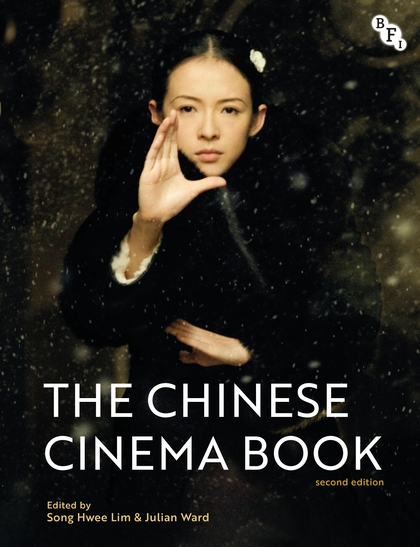Books: Chinese Cinema
June 27, 2020 · 0 comments
By Jonathan Clements.
 Hot on the heels of The Japanese Cinema Book, Bloomsbury puts out a new edition of The Chinese Cinema Book, edited by Lim Song Hwee and Julian Ward. Perhaps reflecting smaller returns, both citationally and financially, The Chinese Cinema Book is half the size of its Japanese stablemate, despite China being one of the world’s largest film markets, but such contradictions are a feature of “Chinese cinema” itself – a massive creative industry with huge restrictions on creativity; a huge population of potential cinema-goers, most of whom apparently have better things to do; and a vast network of cinemas, a worrying number of which seemingly play films nobody wants to see.
Hot on the heels of The Japanese Cinema Book, Bloomsbury puts out a new edition of The Chinese Cinema Book, edited by Lim Song Hwee and Julian Ward. Perhaps reflecting smaller returns, both citationally and financially, The Chinese Cinema Book is half the size of its Japanese stablemate, despite China being one of the world’s largest film markets, but such contradictions are a feature of “Chinese cinema” itself – a massive creative industry with huge restrictions on creativity; a huge population of potential cinema-goers, most of whom apparently have better things to do; and a vast network of cinemas, a worrying number of which seemingly play films nobody wants to see.
Chris Berry’s opening essay trots out the term transnational, long a buzzword in cinema studies, but particularly relevant in the 2020s, when so many “Hollywood” films are funded with Chinese money, and there is a rising tide of Sinopuddings like The Great Wall. Zhang Yingjin considers the problem of a “national” cinema that must somehow appeal to over a billion people, encompassing more than fifty ethnic groups and a diaspora that dwarfs some foreign countries. You can buy entire books on the national cinema of say, Finland, but the whole population of that country would fit comfortably inside a single medium-level Chinese city.
Lim Song Hwee delves deeper into this problem, asking specifically what we mean when we talk about “Chinese” cinema – do we mean the country, in which case what about the Republic of China on Taiwan, or Singapore, or Hong Kong? Or do we mean cinema in Chinese, and if we do, which form of Chinese? Seriously, what hope is there of containing the multitudes of China, a country that could literally swallow ten Japans, within just 340 pages? The editors and contributors have had to embark on an exercise of extreme, capable triage, distilling a subject of such impossible vastness into 23 chapters and an extensive bibliography as a gateway to further study.
 It is with some relief that we still get the basics, in a series of chronological essays taking us through the story of Chinese film up to 1949 – early pioneers, the ferment of 1930s Shanghai, and the contribution of the Man-ei studio run by the Japanese in Manchuria. Four further chapters run through the “forgotten period” from 1949-80 – two on films in the People’s Republic, and one each on Taiwan and Hong Kong. Martial arts films get two chapters as well, divided sensibly between the periods pre- and post- Crouching Tiger, Hidden Dragon.
It is with some relief that we still get the basics, in a series of chronological essays taking us through the story of Chinese film up to 1949 – early pioneers, the ferment of 1930s Shanghai, and the contribution of the Man-ei studio run by the Japanese in Manchuria. Four further chapters run through the “forgotten period” from 1949-80 – two on films in the People’s Republic, and one each on Taiwan and Hong Kong. Martial arts films get two chapters as well, divided sensibly between the periods pre- and post- Crouching Tiger, Hidden Dragon.
Several years ago, I was approached by a well-known film company with a Chinese subsidiary that was in the market for animation feature scripts. They needed a feature project that would allow them to spend some of the capital that was effectively trapped in China, and for that, they needed a script with global appeal but a Chinese subject. It could have been the opportunity of a lifetime for me, and I had plenty of ideas, but every single one of them was defeated by the spectre of what the censor might say – that intractable hydra that refuses to allow dissent, superstition, discussion of half of the things that make China remotely interesting. I wanted to retell Aladdin in its “original” Xinjiang setting. I wanted to make an ethnically-accurate Mulan, suffused with Xianbei weirdness. I wanted to tell stories of the Taiping religious fanatics, or the pirate king who stood up to the Manchus. But every idea came with potential triggers – too tribal, too controversial, too likely to be shut down for “historical nihilism”, that catch-all Party category for any historian who dares to question current assumptions. Those same censors later turned around and waved through Pixar’s Coco because ghosts are okay after all if they have hearts, or something. Eventually, I gave up even trying.
Matthew D. Johnson’s chapter on “Censorship, Propaganda and Film Policy” is hence an extremely welcome account of what gets cut from foreign films and what pressures are placed on local film makers. You want to make a film that offers “an off-beat and humanising perspective” of the war against Japan? Not going to happen. But Johnson argues that the censor is really not quite the problem it appears to be – fully half the Chinese films made in some years, he suggests, fail to make to cinemas because of mundane market forces and box office competition.
 Yomi Braester’s chapter on modern film in the PRC is the touchstone for understanding these contradictions, incisively outlining a critical vocabulary for discussing the contemporary mainstream, such as a “main melody” that allows film-makers to dance to the tune of prevailing political fads, or “bankable dissent” that establishes the parameters for being just edgy enough. He also alludes to what, for me, is an issue big enough and important enough to warrant an entire chapter to itself: “ghost screenings” in which an unwatchable film plays to a non-existent audience, solely so that dodgy financiers can tot up a theatre’s worth of fake ticket stubs, and entirely skewing everybody’s idea of what is actually “popular.” In an environment that has seen multiple cases of money-laundering and box-office stuffing, I would have appreciated a fuller exhibition-focussed account of the economics of Chinese film – an environment where the makers of Monster Hunt give away free tickets in an attempt to maintain a narrative of packed cinemas, and where Fan Bingbing gets caught signing two contracts, one with her actual salary, and the other with the one she reports to the tax office.
Yomi Braester’s chapter on modern film in the PRC is the touchstone for understanding these contradictions, incisively outlining a critical vocabulary for discussing the contemporary mainstream, such as a “main melody” that allows film-makers to dance to the tune of prevailing political fads, or “bankable dissent” that establishes the parameters for being just edgy enough. He also alludes to what, for me, is an issue big enough and important enough to warrant an entire chapter to itself: “ghost screenings” in which an unwatchable film plays to a non-existent audience, solely so that dodgy financiers can tot up a theatre’s worth of fake ticket stubs, and entirely skewing everybody’s idea of what is actually “popular.” In an environment that has seen multiple cases of money-laundering and box-office stuffing, I would have appreciated a fuller exhibition-focussed account of the economics of Chinese film – an environment where the makers of Monster Hunt give away free tickets in an attempt to maintain a narrative of packed cinemas, and where Fan Bingbing gets caught signing two contracts, one with her actual salary, and the other with the one she reports to the tax office.
Paula Voci’s chapter on new digital directions mentions that animation has become, “one of the largest areas of investment in Chinese creative industries” in recent years. However, in this edition at least, animation is largely confined to footnotes. Voci points to books like Sean MacDonald’s and Wu Weihua’s (although not Daisy Yan Du’s), already familiar to readers of this blog, but it seems that despite a history as long as Chinese cinema itself, Chinese animation is yet to be rated of sufficient importance to merit its own chapter.
I don’t necessarily disagree – it would have been nice to see a chapter on the subject, but as the editors note, The Chinese Cinema Book is a work in progress – this edition adds some new topics to its 2011 text, and throws another chapter out, presumably considered no longer of relevance. Government initiatives even write Chinese animation into the Five-Year Plans, but as I have noted elsewhere, you can’t create a viable creative industry by proclamation. It would not surprise me at all, when the next edition rolls around in a decade, if Chinese animation finally gets a chapter to itself. But it will have to fight for every page, against competition from so many other facets of a huge medium that understandably struggles to fit between two covers.
Jonathan Clements is the author of A Brief History of China. The Chinese Cinema Book is out now from Bloomsbury.
Leave a Reply